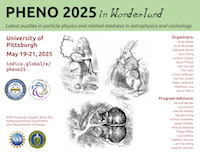Speaker
Description
We perform a global extraction of the $\rm^{12}C$, $\rm^{40}Ca$ and $\rm^{56}Fe$ longitudinal (${\cal R}_L$) and transverse (${\cal R}_T$) nuclear electromagnetic response functions from an analysis of all available electron scattering data on these nuclei. The response functions are extracted for energy transfer $\nu$, spanning the nuclear excitation, quasielastic (QE) scattering with one nucleon (1p1h) and two nucleon (2p2h) final states, and the resonance and inelastic continuum. We extract ${\cal R}_L$ and ${\cal R}_T$ as functions of $\nu$ for both fixed values of $Q^2$ and also for fixed values of 3-momentum transfer $\bf q$. Given the nuclear physics common to both electron and neutrino scattering from nuclei, extracted response functions from electron scattering spanning a large range of $Q^2$ and $\nu$ also provide a powerful tool for validation and tuning of neutrino Monte Carlo (MC) generators. For $\rm^{12}C$ we compare the measurements to theoretical predictions including Energy Dependent-Relativistic Mean Field(ED-RMF), Green's Function Monte Carlo (GFMC), Short Time Approximation Quantum Monte Carlo(STA-QMC), an improved superscaling model (SuSAv2), Correlated Fermi Gas"(CFG), as well as the Nuwro and Achilles generators. For $\rm^{12}C$ we find that combining the ED-RMF-QE-1p1h predictions with the SuSAv2-MEC-2p2h predictions provides a good description of ${\cal R}_L$ and ${\cal R}_T$ for both single nucleon (from QE and nuclear excitations) and two nucleon final states over the entire kinematic range. For $\rm^{40}Ca$ and $\rm^{56}Fe$ we focus on comparisons of the measurements to the predictions of ED-RMF and SuSAv2.

